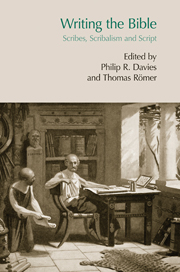Book contents
- Frontmatter
- Contents
- Abbreviations
- 1 Introduction
- I Writing in the ancient world
- II Hebrew Bible and early Judaism
- III Early Judaism and early Christianity
- 10 Some scribal features of the thematic commentaries from Qumran
- 11 Efficacious writing: the inscription of the rosette on the High Priest's forehead and the Egyptian reception of Exodus 28
- 12 The prose writer (συγγραφεύς) and the cultures of author and scribes: the examples of Galen and the anonymous author of Luke-Acts
- 13 Peter and his secretary in Pseudo-Clement
- 14 On the danger of writing according to Origen
- Index of biblical and other ancient sources
- Author index
13 - Peter and his secretary in Pseudo-Clement
- Frontmatter
- Contents
- Abbreviations
- 1 Introduction
- I Writing in the ancient world
- II Hebrew Bible and early Judaism
- III Early Judaism and early Christianity
- 10 Some scribal features of the thematic commentaries from Qumran
- 11 Efficacious writing: the inscription of the rosette on the High Priest's forehead and the Egyptian reception of Exodus 28
- 12 The prose writer (συγγραφεύς) and the cultures of author and scribes: the examples of Galen and the anonymous author of Luke-Acts
- 13 Peter and his secretary in Pseudo-Clement
- 14 On the danger of writing according to Origen
- Index of biblical and other ancient sources
- Author index
Summary
INTRODUCTION
In the Homilies of Pseudo-Clement, the concept of Scripture is articulated in two registers, the scriptural past and the present of the characters of the romance. Scripture, as any written work, escapes the control of those who put it down in writing as soon as it is disseminated beyond the circle that produced it. This problem was particularly acute for the Pseudo-Clementine authors who strove to transmit the doctrines and teachings of Peter and his companions that they considered normative. In the scriptural past the problem is tied to the “false pericopes”. In the present world of the romance, protecting the true meaning of the Apostle Peter's writings required a number of rhetorical techniques. Among passages dealing with our theme we shall leave aside the story of how the philosopher Appion Plistonices composed, overnight, a work in praise of adultery, because it has recently received a fine study (Côté 2008).
THE PSEUDO-CLEMENTINE CORPUS
The Elements of the Pseudo-Clementine Corpus
The Pseudo-Clementine Corpus comprises two main documents: the Homilies and the Recognitions. The twenty Homilies are written in Greek, while the ten books of the Recognitions are transmitted in Rufinus's translation of a mostly lost Greek recension quite different from the recension of the Homilies. At the beginning of the Homilies are found an Epistle of Peter to James (EpPeJ), a Diamarturia (Diam) and an Epistle of Clement to James (EpClemJ). Some manuscripts also transmit the Epistle of Clement to James at the end of the Recognitions.
- Type
- Chapter
- Information
- Writing the BibleScribes, Scribalism and Script, pp. 177 - 188Publisher: Acumen PublishingPrint publication year: 2013



